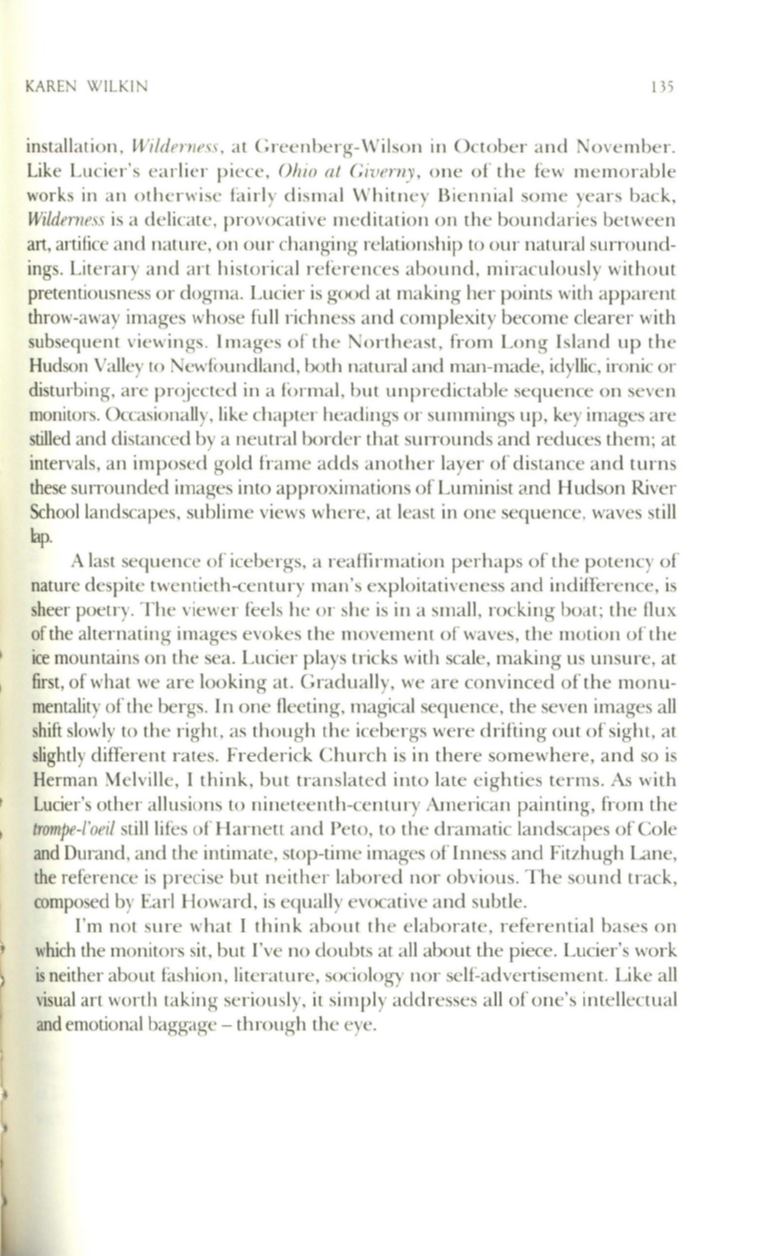
KAREN WILKIN
135
installation,
Wilderness,
at Greenberg-Wilson in October and November.
Like Lucier's earlier piece,
Ohio at Civemy,
one of the few memorable
works in an otherwise fairly dismal Whitney Biennial some years back,
Wilderness
is a delicate, provocative meditatioll on the boundaries between
art, artifice and nature, on our changing relatiollship to our natural surround–
ings. Literary and art historical references abound, miraculously without
pretentiousness or dogma. Lucier is good at making her points with apparent
throw-away images whose full richness and complexity become clearer with
subsequent viewings. Images of the Northeast, from Long Island up the
Hudson Valley to Newfc)llndland, both natural and man-made, idyllic, ironic or
disturbing, are projected in a f(lfInal, but unpredictable sequence on seven
monitors. Occasionally, like chapter headings or summings up, key images are
stilled and distanced by a neutral border that surrounds and reduces them; at
intervals, an imposed gold fi-ame adds another layer of distance and turns
these surrounded images into approximations of Luminist and Hudson River
School landscapes, sublime views where, at least in one sequence, waves still
lap.
A last sequence of icebergs, a reafli rmation perhaps of the potency of
nature despite twentieth-century man's exploitativeness and indifference, is
sheer poetry. The viewer feels he or she is in a small, rocking boat; the flux
of the alternating images evokes the movement of waves, the motion of the
ice mountains on the sea. Lucier plays tricks with scale, making us unsure, at
first, of what we are looking at. Gradually, we are convinced of the monu–
mentality of the bergs. In one fleeting, magical sequence, the seven images all
shift slowly to the right, as though the icebergs were drifting out of sight, at
slightly different rates. Frederick Church is in there somewhere, and so is
Herman Melville, I think, but translated into late eighties terms.
As
with
Lucier's other allusions to nineteenth-century American painting, from the
trompe-l'oeil
stilllifes of Harnett and Peto, to the dramatic landscapes of Cole
and Durand, and the intimate, stop-time images of Inness and Fitzhugh Lane,
the reference is precise but neither labored nor obvious. The sound track,
composed by Earl Howard, is equally evocative and subtle.
I'm not sure what I think about the elaborate, referential bases on
which
the monitors sit, but I've no doubts at all about tile piece. Lucier's work
is
neither about fashion, literature, sociology nor self-advertisement. Like all
visual art worth taking seriously, it simply addresses all of one's intellectual
and emotional baggage - through the eye.


